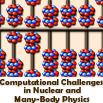Speaker
Yang SUN
Description
In performing shell-model calculations for large nuclear
systems, the central issue is how to truncate the
shell-model space efficiently. It corresponds to a proper
arrangement of the configuration space to separate the most
important part from the rest of the space. There are
different schemes for the shell-model truncation.
Considering the fact that most nuclei in the nuclear chart
are deformed, using a deformed basis supplemented by angular
momentum projection is an efficient way. Shell-model
Hamiltonian is then diagonalized in the projected basis. The
method is in principle independent of how a deformed basis
is prepared and how an effective interaction is chosen. This
approach may be viewed as to bridge the two traditional
nuclear physics methods: the deformed mean-field
approximation and the conventional shell-model
diagonalization, because it keeps all the advantages that a
mean-field model has to incorporate important correlations,
and has the properties of the conventional shell-model that
configurations are mixed beyond the mean-filed states to
include effects of residual interactions. In this talk, we
present the above idea by taking the Projected Shell Model
and its extensions as examples [1,2,3,4]. Given the strong
demand for shell model calculations also from nuclear
astrophysics, one needs such an approach that contains
sufficient correlations and can generate wave functions in
the laboratory frame, thus allowing exact calculations for
transition probabilities, spectroscopic factors, and
beta-decay and electron-capture rates, in heavy, deformed
nuclei. This research is supported by the National Natural
Science Foundation of China (No. 11135005) and by the 973
Program of China (No. 2013CB834401). [1] K. Hara, Y. Sun,
Int. J. Mod. Phys. E4 (1995) 637. [2] Y. Sun and C.-L. Wu,
Phys. Rev. C68 (2003) 024315. [3] Y. Sun, Int. J. Mod. Phys.
E15 (2006) 1695. [4] Y. Sun, Rev. Mex. Fis. S54(3) (2008) 122

